St. Cloud, MN
619 W St. Germain St., Suite 214
St Cloud, MN 56301
(320) 203-4840
Green Bay, WI
520 N Broadway, Suite 205
Green Bay WI, 54303
(920) 884-1496
St. Cloud, MN
619 W St. Germain St., Suite 214
St Cloud, MN 56301
(320) 203-4840
Green Bay, WI
520 N Broadway, Suite 205
Green Bay WI, 54303
(920) 884-1496
Everything you need to know to thrive as a third-party logistics (3PL) provider when it comes to sales and marketing.


We understand the pressure you are under to close deals. In an industry with over 17,000 competitors, and many salespeople fighting for the same customers, it’s hard to be at “the front of the line” when customers need you. In addition, you’re up against a churn of external, often uncontrollable, factors like tight deadlines, changing loads, unreliable drivers, poor weather, etc. It’s a volatile industry with competitors who offer the same services but are unreliable, bidding for jobs that aren’t always suitable for them.
It’s hard to stand out to customers to show intangible, but valuable, characteristics such as completion rates, reliability, attention to detail, communication, and follow through. You’re answering endless questions, calls, and emails. With all that, it can be hard to hit sales goals. You’ve got a lot on your plate. The pressure and challenge to succeed has increased tenfold since the COVID-19 pandemic set in and altered the world’s supply chain
We understand what it takes to get in front of customers, lead them closer to purchase, and keep them happy along the way. (Want proof? Check out this story.) As marketers, that’s what we do. We know your close rate is your own. We’re not after those numbers. We’re here to arm you with the tools, information, and processes that prospects need. We’ll provide you with a consistent framework for hitting sales goals.
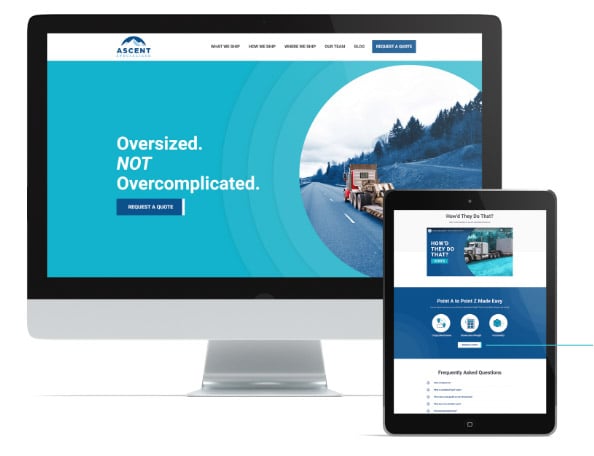
There is a perception in the freight brokerage industry that marketing doesn’t work. For much of the industry, there are hundreds of salespeople in the queue for every worthwhile prospect. If a brokerage partner fails to perform, the client need only pick up their phone and dial up the last person to leave a message.
While this may be true to a degree, it’s an oversimplification of a client’s decision-making process. Just like any other buyer, these clients are looking for more than an immediate solution. They’re looking for a reliable, competitively-priced logistics expert. They’re looking for a partnership. At the end of the day, your customers want to work with the best—a partner who ranks in the top 5% of brokerage firms.
So how do you convince them you compete in the top 5%? How do you build an impression so that your salespeople are selected from the 100-person lineup? This is achieved by aligning sales and marketing.
The logistics industry is undergoing a transformation to a digital ecosystem. Harvard Business Review outlines it well:

While disruptors like Amazon, Uber, and Deliveroo may not challenge all aspects of third party brokerage, they mark a new era for the logistics industry. One where technology and customer service converge, giving the customer ultimate access and control over the process.
You can ascend to these new expectations by implementing marketing and sales automation. If you are relying on “tribal knowledge”—information gathered over time and held in brains rather than on paper—you will inevitably fall behind. Manual processes cap growth, lead to issues, and lack scalability.


This might seem obvious, but having goals, writing them down, and sharing them with your whole team is crucial. While it might seem like a no-brainer, many freight brokerages lack clarity when it comes to goals. Often, there is a singular goal around a revenue number. While having a revenue goal is critical, it’s far from the only thing that will propel your company's growth.
You first must start with your overall company goals. Perhaps those goals are around revenue, team size, profitability per load, time to execute, etc. From there, we suggest setting sales and marketing goals that support the overarching goals. The sales and marketing goals should work together, not in silos. Ultimately, they should be the benchmarks for achieving the larger company goals.
In this chapter, we’ll give you tools and tips on setting goals and metrics around those goals.

Perhaps you already have a process for setting annual goals. For many companies, it’s a simple process of adding a percentage of growth beyond what was accomplished in the prior year. While this is one area to focus on, it is far from the only important goal to work toward.
If your company operates under a formal business operating structure, you likely follow a specific process to identify and set goals. An example of this is the Entrepreneurial Operating System (EOS) based on the book Traction, by Gino Wickman (this is the system we use at Vye, with great success!).
Whatever your process, there are certain things that can help improve the quality of your goals:
Whether your goals revolve around increasing market share and revenue or recruiting quality team members, many goals may lead back to marketing efforts. Marketing is a broad term that encompasses a large number of strategic tactics. Here are some common marketing metrics to measure.
Need a little help? Use this calculator to determine key marketing goals. You can either download the file as a Microsoft Excel file or clone to your Google Drive account to plug in your own numbers.
Similar to marketing, you will find that most company goals rely on sales team performance. This could be based on individual salesperson performance or entire team performance. Here are some common sales metrics to measure:
With strong goals in place, your next step is to create a marketing and sales strategy to achieve the goals. We’ll dive into setting a strong strategy foundation in the next chapter.


Football teams have playbooks for a reason. Sure, the goal might be to win the game. And everyone might be on the same page about that goal. But without the playbook, players will run around aimlessly, trying to make the win happen in silos (and chaos).
When it comes to your freight brokerage business, one thing is certain: a clear strategy to support your goals is critical. Strategies come in all shapes and sizes, but there are a few must-haves:
When all is said and done, your customers all want the same thing: reliable service at a fair price. They want to be able to call you at any time of day and get an immediate quote. They want you to know exactly what’s needed. Licenses? Escorts? You name it. They expect you to handle it.
While customers may have an end goal in common, defining your target audience can be anything but simple. Whether you’re working with a shrimp distributor on a reefer load, or a wind energy manufacturer on an oversized turbine load, your customers come from a variety of backgrounds and needs.
Not only is it vital to understand who the end customer is and how to reach them, but it's also important to understand your driver/carrier audience. Finding the right partners is vital to hitting your company goals.
It’s important that your team be aligned on who you’re targeting. This is especially important for new employees. We recommend creating a profile of your ideal client. We call this a persona. Here are some questions that must be explored while building a persona:
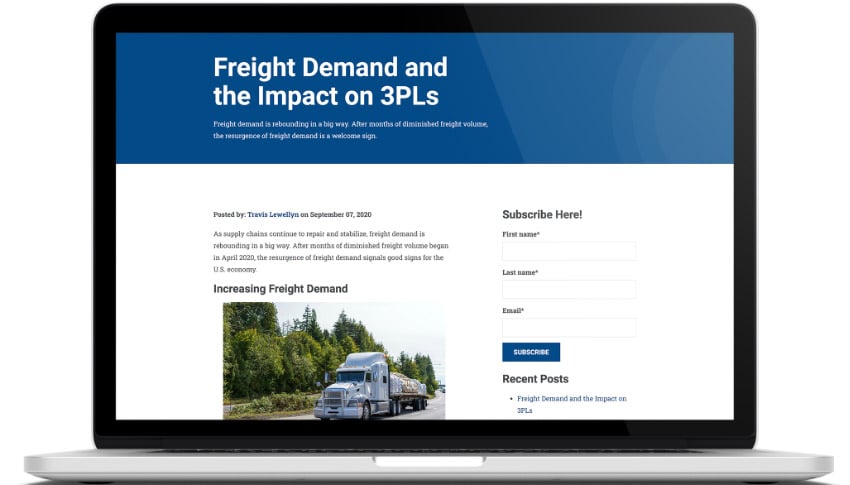
Examples: Turbine, Food and Dairy, Aviation, Shipbuilding, Agricultural, etc.
Examples: Operations Manager, Logistics Manager, Import/Export Director
Examples: LTL, flatbed specialized, over-dimensional, heavy haul, dry van shipping, reefer, LO/LO, just-in-time/quick response, reverse logistics
Examples: Supply Chain Digital, SDCE, Logistics Brief, LinkedIn
Examples: price, quote response time, quality of delivery, accuracy of arrival time, etc.
Examples: How much will this cost? What’s your track record? Have you worked with my industry before? What’s your insurance policy?
Examples: Lack of loyalty, lack of communication, lack of expertise
Once you’ve built a profile that covers much of who you aim to target, it’s important to share with your full team so everyone is aligned. If you struggle to capture your ideal customer in one persona, keep in mind that it’s normal for a business to have several personas.
Real-world example of a persona:
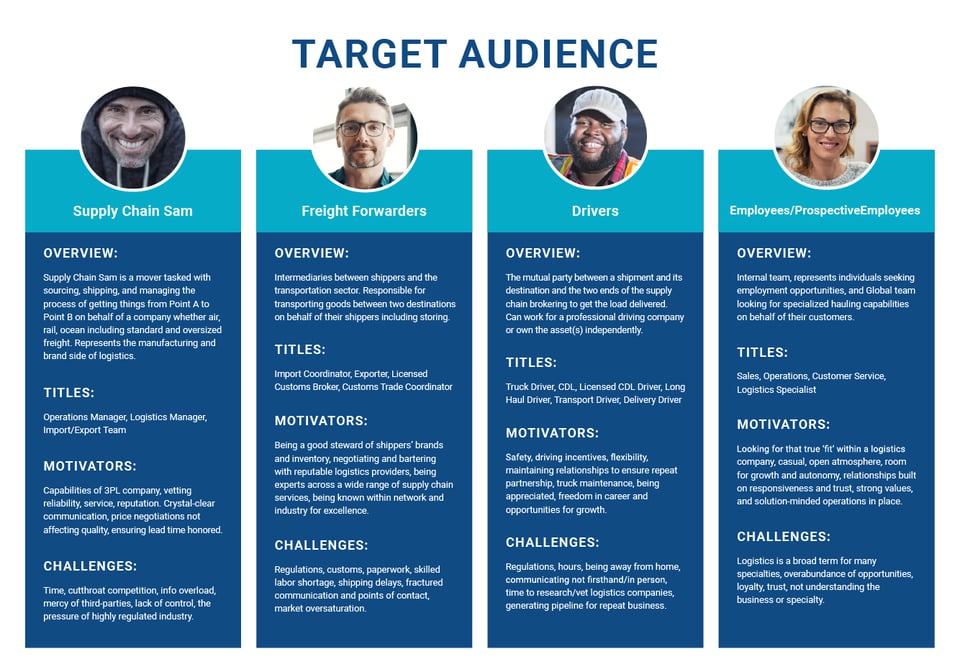
Want to build a persona? Check out this free, Buyer Persona Worksheet.


Here’s an experience familiar to many who start out in the 3PL sales business: On their first day they’re given a phone, an email address, and some pointers on how to find prospects. From there, they are set free to navigate business, culture, best practices, and more on their own.
This is a terrible situation and can be avoided with proven practices for onboarding and retaining new employees, which we cover in Chapter 4. But first, let’s talk about brand.
Brand is not a logo. It’s the promise you make to your customers. It’s the experience they have while working with you. It’s the things your customers say behind your back. How do you create a consistent experience from start to finish that will delight your customers and keep them coming back for more?
A lot of this falls on sales to quote quickly and accurately, operations to manage the loads expertly, and the whole team to over communicate with each other and the customer. But before any of that can happen, the customer must be compelled to work with you. This can be done through powerful, bold messaging.
When building a value proposition, it’s incredibly important that you focus the statement on the customer, not yourself. Remember, they are the hero of the story. You are simply the guide— the resource for them to achieve their goals. Your value proposition should focus on your prospect’s problem, and how you solve that problem uniquely, efficiently, and with expertise.
When you build your value proposition, you should limit the differentiators you talk about. An analogy we use in the marketing world is: “If everything is bold, then nothing is.” If you say you do everything exceptionally well, the assumption is that you, in fact, do none of them well. And if you’ve defined your target market well enough, it should be clear that some of these surface as priorities. Of course, everyone wants everything: the lowest price, fastest service, error-free, etc. But, as with any industry, your targeted prospects will have priorities. Uncover those priorities and position them within your value proposition.
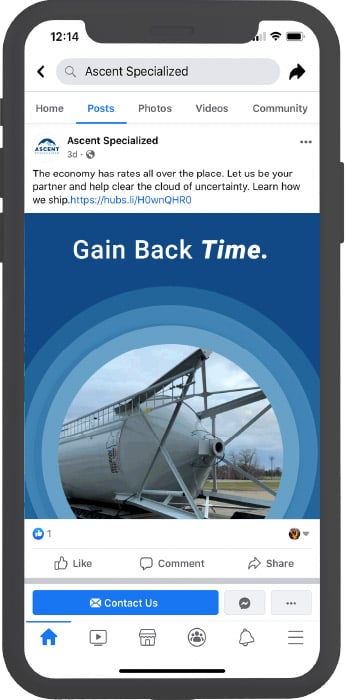
The competitive landscape in the 3PL industry is crowded and cutthroat. With over 17,000 players in the game, we know it’s not easy to pin down just a few organizations as competitors. We suggest thinking about competitors not only as the companies that directly take away your business, but also the players who you aspire to be.
Monitoring what your aspirational competitors are doing on their website, paid media, and social media will give good insight as to where you should invest time, energy, and money. For example, if your aspirational competitors are including video heavily within their marketing and sales strategy, that might be a key indicator that you should also explore video.
While there are aspects of a competitor’s marketing strategy that can be seen just by visiting their website and social platforms, there are many valuable metrics that are under the hood. Here are a few key metrics that indicate success on digital platforms:
While it can be hard to assess all of these metrics on a competitor’s website, especially without expensive auditing tools, a good first step would be to run your website through this free Marketing Grader, and then do the same with your competitors' websites.


If you want reliable, measurable results you’ve got to follow a methodology. A methodology is like a recipe. Follow the same process, get a predictable result. If you’re like most companies, you want:

You want a self-sustaining cycle you can rely on. We found that in the Inbound Flywheel.
The Inbound Flywheel methodology is a process in which you gain momentum by reducing friction. When you connect your sales, marketing, and service you can drive lead generation online and close deals faster. HubSpot defines the stages of the flywheel as:
“In the attract phase, you attract visitors with useful content and eliminate barriers as they try to learn about your company. The key is to earn people's attention, not force it. Some forces you can apply are content marketing, search engine optimization, social media marketing, social selling, targeted paid advertising, and conversion rate optimization.
In the engage phase, you make it easy to shop and buy from you by enabling buyers to engage with you on their preferred timeline and channels. Focus on opening relationships, not just closing deals. Some forces include website and email personalization, database segmentation, marketing automation, lead nurturing, multichannel communication (chat, phone, messaging, email), sales automation, lead scoring, and try before you buy programs.
And finally, in the delight phase, you help, support, and empower customers to reach their goals. Remember, customer success is your success. Some forces you can leverage are self-service (Knowledge base, chatbot), proactive customer service, multichannel availability (chat, messaging, phone, email), ticketing systems, automated onboarding, customer feedback surveys, and loyalty programs.”
HubSpot pioneered the Inbound Flywheel methodology. You can read more about this methodology here.
For long-lasting momentum and team accountability, you must have alignment between your sales, marketing, and operations teams through a Service Level Agreement (SLA). This is sometimes called Sales and Operations Planning or Sales and Marketing Agreement. These formalized agreements ensure:
A Service Level Agreement (SLA) is a contract between departments that outlines specific deliverables in the form of numbers or metrics. A good SLA will include:
Example: Marketing agrees to generate X number of leads, Sales agrees to close the loop on each lead within two hours, and Operations agrees to nurture the client relationship through X communication checkpoints.
Each department will likely have their own separate—but connected—goals
This might include weekly or daily status updates, regular stand-up meetings, etc.
Who is responsible in each department to ensure goals and expectations are met?
An agreed upon plan B if goals are not met
HubSpot offers a great article on how SLAs can be used for internal departments as well as client relationships.
In chapter five we will uncover ways to put your strategy in motion. We’ll provide specific marketing and sales tactics to help you thrive as a 3PL. We’ll show you how to execute the tactics. But first, we need to solve a problem: the Sales Team 20-70-10 Rut.


If your business is like the majority of 3PLs, your sales team might look something like this:
This kind of rut is detrimental to growth.
If you want to be a top tier logistics brokerage, you have to find a way to get your okay people to crush it, and avoid the bottom 10% altogether. How do you do this? Follow the recipe to find, recruit, and retain the best people.
Logistics is known for high burnout in sales staff and thus requires a specific type of person to succeed when it comes to sales. Many companies find it difficult to onboard and keep staff, much less find employee rockstars with tenacity and curiosity. The industry can feel like a never-ending cycle of chaos.
How do you cut through the clutter and find the best salespeople? We’ve helped companies like Granite Logistics do just that. Read on to find out how.
Much like ideal prospective clients, it’s vital to build a profile of your ideal sales employee. What are their primary characteristics? What words describe them? What personality type works in the role? Here are some common themes we’ve found in our research:
Real-world example of a persona:
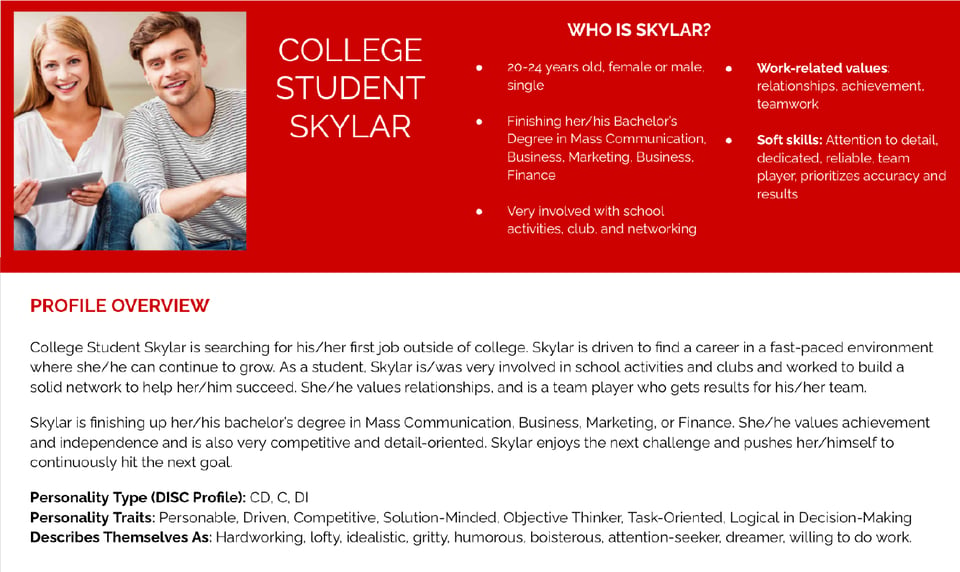
Note: Much of this applies to identifying your ideal Operations employees as well.
You can recruit top talent through word-of-mouth and recruitment agencies, but one of the most powerful ways to improve success with top talent is to build your employer brand. While similar to your organization’s brand, your employer brand speaks to your reputation and approach with employees (i.e. how employees describe their experience with your company), culture, and work. Here are some of the top tactics we’ve initiated on career pages, job postings, and social media to help build an employer brand:
Prospects want to know about your pay structure. We know this can be a sensitive topic. But how can you find ways to set expectations while leaving flexibility for an individual’s unique approach? Can you showcase a typical commission structure? Can you talk about base pay? Can you speak in averages? Remember to share details about pay structure such as growth opportunities, timing of performance reviews, team goals/incentives available, frequency of commissions paid, etc. Cover broad beliefs and practices related to compensation such as the sales teams’ connection to the company’s bottom line, non-cash incentives or perks such as product or service bonuses and trips. Don’t forget to outline the benefits your company offers, such as health insurance, short- and long-term disability, retirement plans, paid time off, provided technology, etc.
What differentiates your company from other 3PLs? How about from other sales organizations? Outline these clearly, boldly, and proudly. Don’t forget to back it up with data. That could include things like: employee survey results, awards and accolades, employee testimonials, average tenure of employees, community involvement, etc. Culture is more than having a ping pong table in the breakroom. Prospects want to understand the team dynamic and what to expect if they join your team.
Video is a versatile media that works well on a website, within social media platforms, through paid media efforts, etc. The data shows that video is, by far, the preferred method of media consumption. According to Cisco, by 2022, online videos will make up more than 82% of all consumer internet traffic—15 times higher than it was in 2017. Using video to share about specific positions and the company as a whole is a powerful way to connect with prospects. Here’s an example of a video we did for a client, Granite Logistics.
Competitors can steal more than your leads. Whether you’re a small firm with less than 20 employees, or a larger firm with 50 or more employees, competitors can steal your talent. Not just your current employees, but your prospective employees as well. To outperform your competitors, you must first understand what they’re doing. Check out their website and social platforms to understand how they are positioning themselves and their differentiators. Aim to exceed their efforts.
Need help assessing your top competitors? Let us do the digging for you.
You can build loyalty by creating trust with your prospects. Building trust happens when you provide clear answers and direction. Many sales people outside the 3PL industry will not know much about what to expect. Anything you can share to ease their uncertainty will help set you apart and above your competitors. See a full list of frequently asked questions here.
A compelling Careers page starts with including much of the information listed above. Beyond that, you’ll want to be sure that each position has its own page and is clearly outlined and optimized for search. Some common things found on successful job posting pages include: Robust details about job expectations, a “Quick Apply” form, and information about the company culture.
Reach your target audience through social media by sharing authentic content about the culture and employees. How do you celebrate wins? How do you reward employees? Be sure to feature employee stories and testimonials (especially videos!). Social media offers a great opportunity to share information about your workplace dynamic. Do you host special events? How does your company get involved with the community? Do you have team traditions? Lastly, encourage your employees to share posts on their personal social media platforms. This can be a very powerful way to reach prospective employees.
Leveraging job boards such as LinkedIn Careers, ZipRecruiter, and Indeed are an important part of a well-rounded recruitment process. The amount you spend within each platform should be based on historical data in terms of candidate quality. Don’t have historical data? Start collecting data with your first posting, noting key elements such as number of qualified candidates, number of individuals advanced to the interview process, number of offers extended and accepted. Want a list of job boards to consider? Get it here.
How you survey employees might change based on the number of staff (1-on-1 feedback sessions for small teams, digital surveys for large teams, etc.), but one thing is for sure: gathering data from current employees is critical to hiring the best employees. Collecting information on an annual, bi-annual, or quarterly basis can help you identify trends, differentiators, or gaps in the hiring process, organization, structure, and more. It can also be impactful to ask employees to rate and review your company on third-party websites like Glassdoor, Facebook, or Google.
Create a referral program that rewards employees for successful referral hires. This can amplify a word-of-mouth strategy and also the likelihood of current employees to share information about open positions via email and their personal social channels. A referral program should consider wins for current employees and new hires. Some companies offer current employees a cash bonus for referring new hires and another cash bonus for the referring employee and new hire after the first six months or one year is achieved. Some companies form a hire advocacy team of individuals from throughout the organization who can help recruit, refer, and vet prospective employees. These individuals may also participate in the interview process.


As stated before, this is a high turnover industry. That doesn’t make it any cheaper to recruit and onboard employees. We all know that the time and expense associated with onboarding team members can be extraordinary. How do you make sure those valuable dollars don’t go to waste? By retaining the talent, of course.
Think about your own experience throughout the course of your career. What have companies done to earn your loyalty? What have they done to motivate you to leave? The likely answer is this: The companies that inspired you to work hard and stick around were the ones that offered support and gave you the tools to succeed.
This might seem like a no-brainer, but there are far too many freight brokerage companies that struggle with this very thing. Some would argue that sales in the 3PL industry is more of an art than a science. Some might even argue that it falls to luck, rather than skill; “it’s not what you know, but who you know” mindset.
We disagree. Through our work with 3PLs, we’ve learned how successful companies support their employees and give them the tools to succeed. Here are just a few opportunities:
Starting a new career can be challenging. The fast-paced environment and high expectations of the 3PL industry amplify the challenges. It’s not enough to hand your new employee a phone and tell them to get to work. You need to facilitate a well-organized onboarding process if you want a winning team.
What are tactics that can be put in place to help the new employee feel connected and perhaps begin the onboarding process at their own pace, before day one? Think about company background material that can be read leisurely, human resources paperwork, a welcome gift from the company or team, equipment set up. Most of these details should be managed, and delivered, by the organization with an invitation to the new employee to engage as they are able.
Make a checklist, make sure the new employee has someone (or several people) walking them through the processes and procedures of your company in the first week. What tours should take place? What cultural aspects or conveniences are helpful to know right away, such as customary break times, lunch culture, location of restrooms, and any other key “bonus” areas such as workout facilities, proximity to favorite dining spots, etc. You might consider aligning the new hire with a mentor, who is not a direct report or manager, who can provide companionship and insight throughout the first 90 days of employment.
Avoid informal sessions with the top salespeople. Just because they are your top salespeople doesn’t mean they are great educators. They are typically ill-equipped to share an actionable process, and are sometimes too competitive to share their “secret sauce.”
A CRM tool is an online, dynamic tool that supports the storage of all prospect and customer information. Great CRM systems automatically tie communication efforts to a prospect/customer “profile”. i.e. if you email a prospect/customer, it will be automatically stored in the CRM for future reference. Our favorite tool is the free HubSpot CRM.
Using a CRM tool is critical to help support your sales team by setting expectations and having a defined process for prospect and customer management. This is especially important for new employees. Using a CRM removes the mess of Post-It notes, saved emails, and phone reminders. A CRM tool also allows team members to access client information. This can ensure Operations is able to access critical information about client communication and set expectations. It allows Sales management to see progress and track metrics. Lastly, it allows for easier transition of clients from salesperson to salesperson, if needed
There are many ways to retain your sales staff by supporting them with tools and resources. In the next chapter we will cover:


Marketing, if done well, should be doing just as much as any other business initiative to help you hit your revenue goals. In order to effectively do that, however, you need to have a marketing strategy in place. We talked about setting strategy in Chapter 3. Now we will outline what kinds of tactics could live in that strategy. These are tried and true strategies that have helped not only 3PL companies hit their goals, but companies across nearly every industry.
When it comes to the supply chain, automation is often associated with robots on the warehouse floor, or automated business operating processes and procedures. But in this case, we’re talking about marketing and sales automation.
If you’re looking to tighten up the processes within your organization and create more effective teams, the most impactful thing you can address immediately is automation. Here are a few things that can be automated:
According to Juniper Research, by 2022, 75-90% of queries are expected to be handled by chatbots. And, according to Chatbots Life, chatbots can cut operational costs by up to 30%. These are some pretty powerful stats. While chatbots certainly won’t replace the need for team members in Sales and Operations to take care of customers, they can certainly lighten the load and help address frequently asked questions. This applies to not only prospective and current customers, but also prospective employees. Many companies choose to address the most commonly asked questions with a chatbot, and transition to live chat once the conversation extends to a deeper level of engagement.
In Chapter 4, we outlined how a CRM can be an incredibly powerful and important tool for a sales team. A CRM can operate separately from marketing efforts, but ideally would be connected for maximum impact. By connecting the CRM or TMS to your marketing platforms (like HubSpot or SharpSpring) you can automatically update prospects and customer profiles within your CRM based on the content those users are consuming on your website. That insight can then be leveraged by the sales team to initiate conversations.
Nurturing workflows are a very effective way of taking semi-warm leads and bringing them to the finish line. This can be especially useful when bidding for large, long-spanning projects. Automated emails can deliver relevant content based on the user’s behaviors on the website. Imagine if a prospective is on your capabilities page and clicks through to a subpage about heavy haul loads. What if, based on that action, the contact was delivered an email with a case study on heavy haul loads you’ve done in the past? That is the power of automated emails.
Consistency is key when it comes to publishing content or building a social media presence. This can be hard to do if every post is one-off, or scheduled a week at a time on native platforms. Instead, implementing a powerful marketing automation tool (like HubSpot or Hootsuite) can shave off hours of time spent each month by making it easy and efficient to schedule posts on social platforms and within a blog. The more robust platforms will also allow you to schedule out email communication and control paid media as well.
There’s a misconception in the 3PL industry that opportunities can only be generated through sheer sales outreach efforts. The assumption is that the more sales team members you have making cold calls each day, the more sales opportunities you will generate.
While this is a common approach, it’s far from the only solution that exists. Creating an optimized website that’s designed to produce qualified leads is a tactic that some of the most successful freight brokerage companies have embraced. We’ve seen this approach succeed for our own logistics clients.
An optimized website includes things like:


Your marketing and sales goals will ultimately dictate the tactics you implement. For example, if your goal is to increase visits to the website (thereby increasing awareness and widening the lead generation pool), you would likely want to focus on creating optimized blog content and run paid media campaigns that drive back to the website. Here are some common marketing tactics and what they will result in:
Email marketing often includes audience-specific communications. This could come in the form of a regular newsletter. It could also include automated workflows (outlined above). Keep in mind: plain text emails that come from a specific individual tend to perform best. Even when setting up an automated email workflow you should be able to send from an individual email vs. a generic company email. Want to see more stats about email in 2021? This is a great article.
Social media is particularly powerful in connecting with a specific audience. Social media operates best in the logistics industry as a way to showcase thought leadership by sharing resources, and is especially effective when it comes to reaching your prospective employee audience. Keep the 80/20 rule in mind. 80% of content should be external facing and offer entertainment and value. 20% should be sale-centric. Want to go a layer deeper into social media marketing? This resource outlines best practices for different social platforms. Lastly, you should be encouraging your staff to be active on social media channels by sharing company content and updates. This can help you reach prospective customers and employees.
Creating blog content is an effective way to rank organically for specific terms. For example, if you want to rank for “Wind Turbine Transportation”, you might write a blog: “10 Things to Know About Transporting Wind Turbines”. It’s important to understand the keywords you’re going after before you begin to write. A good place to start is to ask your Sales and Operations teams what questions they get asked all the time, and create content to answer those common questions. Looking for some guidance on how to put together a content plan? You can download this template (or copy it to your Google drive) and fill out each section to give you a solid strategy.
Paid media can be accomplished through several different channels. The most common are: Social Media (these ads appear within a social feed), Search (these ads appear in text format at the top of a search result), and Display (these are banner ads that appear on relevant websites). A powerful paid media strategy is to set up retargeting ads. That means that if a user has visited your site (or even a competitor’s site), they will be served up relevant ads for a period of time following their initial visit. It’s a great way to keep your company top of mind. It’s important to understand who your audience is (outlined in Chapter 3) so you can set up the appropriate targeting strategy and not waste ad dollars.
There is no denying that video is the preferred content format for the vast majority of people. Video allows a user to consume complex information quickly and efficiently. It also offers a better opportunity to connect emotionally with your audience. This could come in the form of short videos showcasing your services and differentiators. It could also come in the form of personalized 1-on-1 sales outreach videos. More on that here.
These are just a few examples of marketing tactics you could use to hit your goals. Need help putting together tactics that will help you hit your goals? Check out this free campaign worksheet resource. Ready to partner with experts who are familiar with the 3PL industry? Get in touch with us.
Measuring your marketing and sales efforts is a vital part of creating value and identifying ROI. If you don’t know the results of your efforts, you won’t know what to cut down or amp up to maximize time and dollars. If you only measure the end result (e.g. annual revenue generated), you might find yourself in a situation where you’re investing hours and hundreds of dollars into things that don’t help your business. When you know what’s working, you can double down on those things to ramp up growth.
Data-driven reporting can be done through a variety of tools:
Not sure what to measure when it comes to marketing? Here’s a metrics benchmark worksheet that outlines industry baseline numbers for some of the top marketing metrics.


As you’ve seen in this resource, running successful sales and marketing campaigns can be complex and time-consuming. If you have limited resources, we suggest picking a single area to focus on and improve. This is not a sprint. It’s a marathon. Good business practices take time and resources to build.
If you’re waiting for a sign to commit to building deeper client relationships, generating more revenue, or growing your team with the right people: this is your sign. We’re rooting for you! And if you need a partner to help, you know where to find us. We have experience in the 3PL industry and we’re ready to help you crush your goals.
Want to see an example of a client we helped? Check out this Ascent Specialized case study.
Whether you just have a few questions and are looking for some professional insight, or you’re looking for a partner to work with for the long haul, we’ve got you covered. Get in touch with our 3PL marketing experts.
